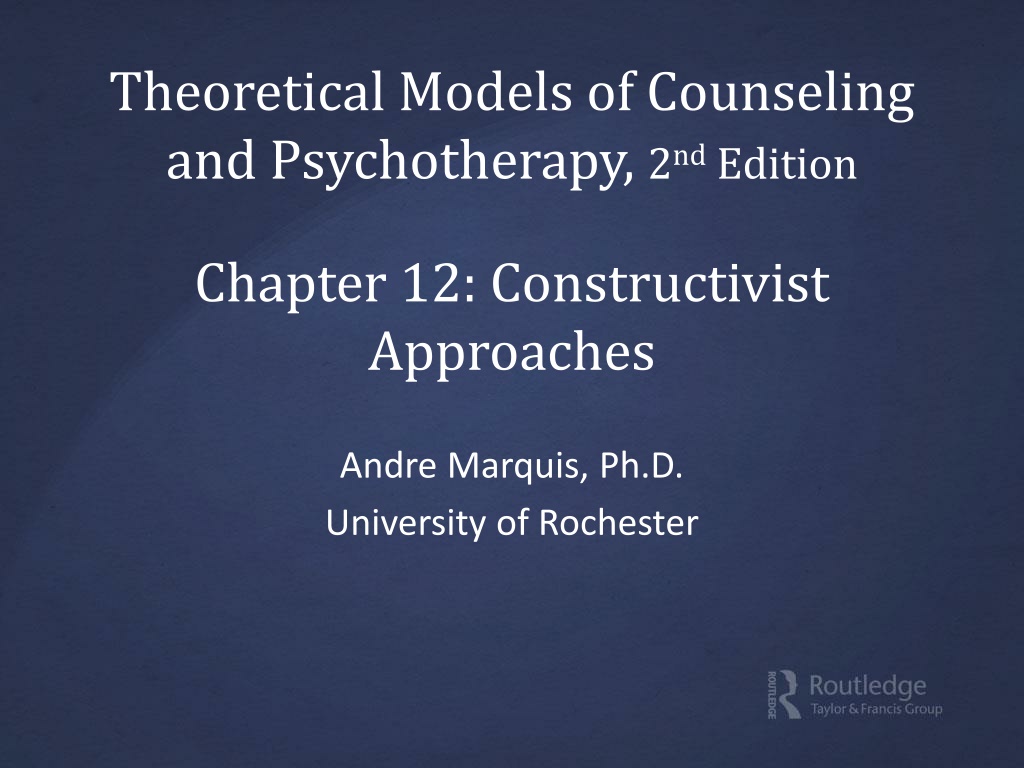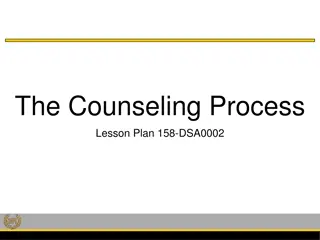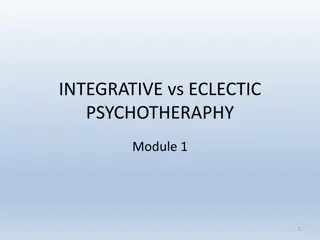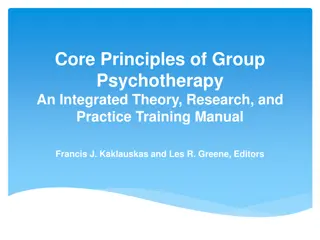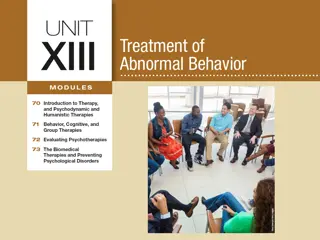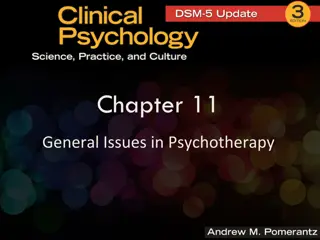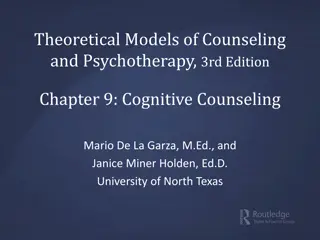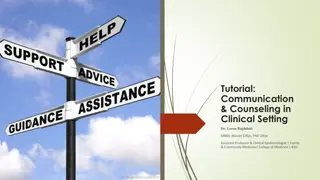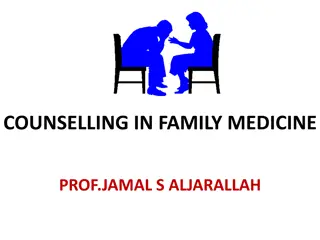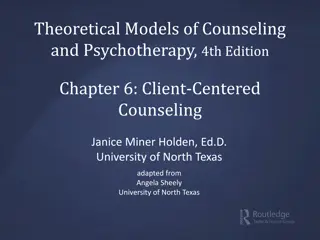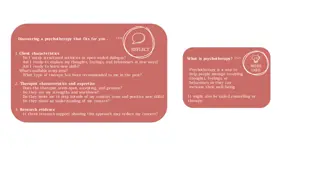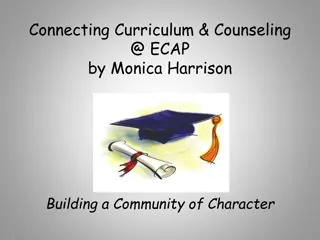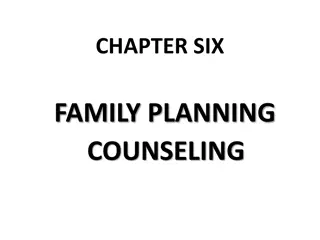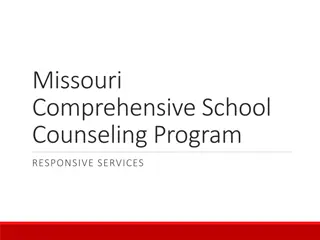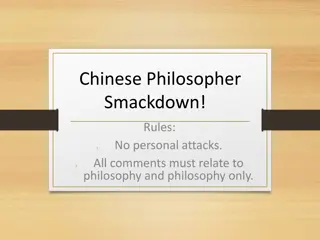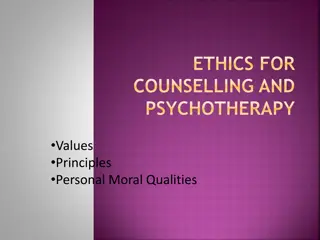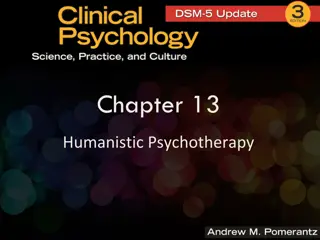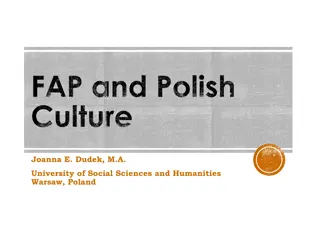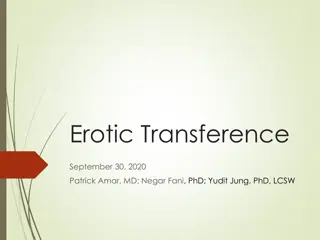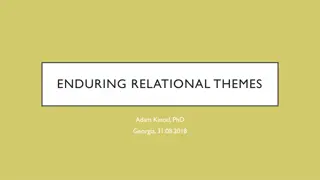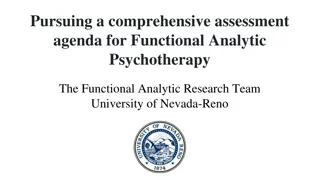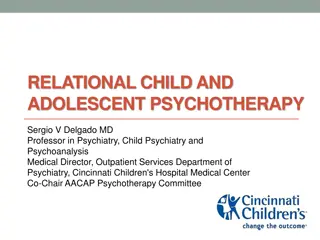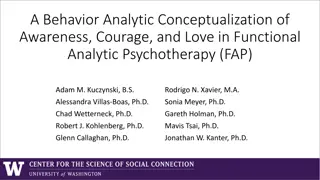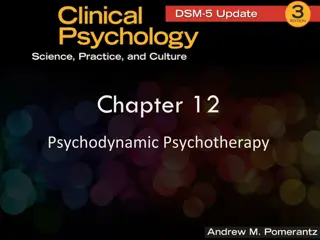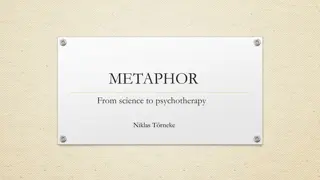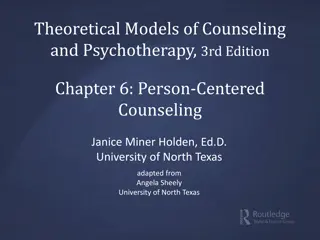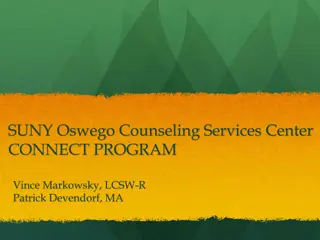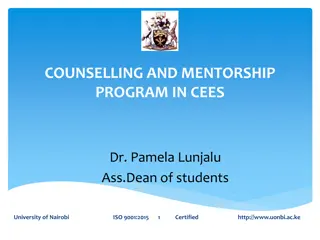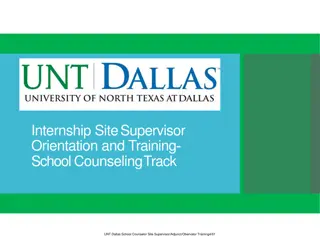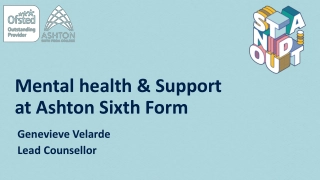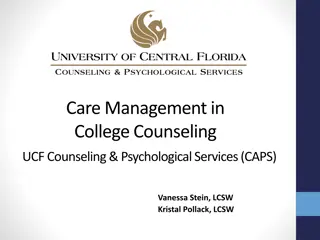Constructivist Approaches in Counseling and Psychotherapy: A Philosophical Perspective
Constructivist approaches in counseling and psychotherapy emphasize the ongoing process of structuring experiences to create meaning. This perspective involves philosophical underpinnings from thinkers such as the Buddha, Immanuel Kant, and Jean Piaget, highlighting the role of individual construction in understanding reality. Founders of Constructivist theory integrate cognitive-behavioral, existential-humanistic, psychoanalytic, and transpersonal legacies. The nature of humans in this framework focuses on the emotional and tacit processes involved in organizing experiences to construct meaning.
Download Presentation

Please find below an Image/Link to download the presentation.
The content on the website is provided AS IS for your information and personal use only. It may not be sold, licensed, or shared on other websites without obtaining consent from the author. Download presentation by click this link. If you encounter any issues during the download, it is possible that the publisher has removed the file from their server.
E N D
Presentation Transcript
Theoretical Models of Counseling and Psychotherapy, 2ndEdition Chapter 12: Constructivist Approaches Andre Marquis, Ph.D. University of Rochester
Historical Context A reaction against the prevailing attitude of narrow empiricism and the search for an objective truth The verb to construct comes from the Latin con struere, which means to arrange or give structure; the ongoing nature of structuring (organizing) processes is at the heart of lifespan development.
Founders There is not a single founder of Constructivist theory. There are many different interpretations about what Constructivist theory looks like in practice: Some emphasize a cognitive-behavioral legacy. Others emphasize existential-humanistic, psychoanalytic, or transpersonal. Michael Mahoney s approach includes and integrates aspects of each of these legacies.
Philosophical Underpinnings The Buddha emphasized the role of minds and thinking in the creation and maintenance of our experience of reality. Giambattista Vico: human knowing involves an imaginative construction of order in experience, and that knowledge must be understood as a process of construction that takes place in social contexts. Immanuel Kant emphasized the power of patterns in our thinking, and he regarded ideas as regulative principles. Kant believed that we participate in the construction of a universal lawfulness. Hans Vaihinger argued that the primary purpose of mind and mental processes is not to portray or mirror reality, but to serve individuals in their navigations through life circumstances.
Philosophical Underpinnings Jean Piaget emphasized that we organize our worlds by organizing ourselves, and this theme of self- organization pervades constructive views of human experience. George Kelly s theory of constructive alternativism, better known as personal construct theory, emphasized both possibility and pattern in the self- organization of personality.
Nature of Humans: Function of Psyche The most primary is to order and organize one s experience and thus, to construct meaning. Mahoney noted a consensual emphasis on five overlapping themes about human experience and development: 1. Human experiencing reflects continuous and primarily anticipatory activity. 2. The ongoing activity of humans is primarily devoted to ordering processes or the organizational patterning of experience; these ordering processes are fundamentally emotional and tacit, and they are the essence of meaning-making.
Nature of Humans: Function of Psyche 3. The organization of personal activity is fundamentally self-referent or recursive, making the body a fulcrum of experiencing and encouraging a deep phenomenological sense of selfhood or personal identity. 4. Self-organizing capacities and creations of meaning are strongly influenced by social-symbolic processes; persons exist in living webs of relationships, many of which are mediated by language and symbol systems. 5. Each human life reflects principles of dynamic dialectical development; complex flows among essential tensions (contrasts) are reflected in patterns and cycles of experiencing that can lead to episodes of disorder (disorganization) and, under some circumstances, the reorganization (transformation) of core patterns of activity, including meaning-making and both self- and social relationships.
Nature of Humans: Structure of Psyche The difference between psychological functions (which are dynamic and frequently in flux) and structures (which are traditionally presumed to be quite stable) is more accurately a matter of time scale. Structures whether a schema or self also can change; they just change more slowly than functions.
Nature of Humans: Structure of Psyche Mahoney strongly believed that it is more accurate to conceive of processes than mechanistic structures. For example, the difference between conceiving the self as verb, activity, or ongoing process in contrast to a noun or structure Operating primarily outside of our awareness, Core Ordering Processes (COPs) are the organizational processes through which we perceive stabilities, continuities, and constancies.
Nature of Humans: Structure of Psyche COPs involve four overlapping themes: 1. Reality refers to one s worldview and perceptual constancies along dimensions such as possible/impossible, real/unreal, and meaningful/meaningless. 2. Value refers to emotional judgments (all judgment requires a valence positive or negative) along dimensions such as good/bad, right/wrong, and approach/avoid.
Nature of Humans: Structure of Psyche 3. Self refers to that with which we identify and our processes of establishing a felt-sense of coherence, continuity, and order to our experience along dimensions such as me/not me, us/them, body/world, and worth/worthlessness. 4. Power refers to one s sense of agency along dimensions such as active/passive, hopeful/hopeless, in control/out of control, and engaged/withdrawn.
Role of the Environment The individual is seen as being in a dialectic relationship with the environment, which means all people react to and act on their environment continually. People do not develop in isolation; it is the interaction between environment and self that provides the building materials for one s personal constructs. Emphasis is given to the individual s interpretation of the environment, especially how he/she can constructively move forward.
Health Constructivists do not define mental health in specific terms. However, developmental constructivism does suggest some general contours of what constitutes relative health. Such a trusting engagement in life (in contrast to passive withdrawal) and having a sense of agency in and authorship of one s life Other aspects of health involve balance and wholeness (integration).
Unhealth Mahoney depathologized many of the concerns clients brought with them to counseling. For example: Because each person is always engaged in active gestures of seeking a dynamic balance in his/her life, a "disordered person" can be viewed as one whose life circumstances exceed their developed integrative skills. Much that is termed unhealthy involves imbalance and segregation of parts from the whole.
Change Process In Mahoney s Human Change Processes, he demonstrated that complex, nonlinear processes are involved. Although he stressed that the particulars cannot be predicted, some patterns are more likely than others. Oscillations are common in the development of new skills and are often apparent in the restructuring of core ordering processes. Exploratory behavior is usually suppressed in the presence of strong negative affect).
Clients Role Clients hold the primary responsibility for change. Each client is seen as a collaborator in the change process. Their role is not passive; it can best be described as engaged. They must be willing to focus on the present and be active participants in goal-setting and experimenting with new ways of thinking, feeling, and acting.
Counselors Role Creating an atmosphere of safety, openness Creating a collaborative working alliance Empathizing with clients struggles and suffering Helping clients realize that they are capable of making positive changes in their lives Promoting change by co-creating various experiments in new ways of thinking, feeling, and behaving that clients practice between sessions
Capacity for Change According to developmental constructivists, the resilience and resourcefulness of the human system is much greater than is generally appreciated. Without ignoring the profound negative influence that genetics or neglectful or abusive early childhoods may exert, we can considerably influence the course of our development throughout the lifespan. At the same time, our potentials for transformation are surely not limitless.
Capacity for Change According to Mahoney, most counseling theorists have grasped part of this issue, but not its complexity: People do express their genetic inheritance, but they do it in highly contextual and individualized ways. Early experiences make big differences in developmental trajectories, yet many people transcend them. Environments do select patterns, yet we select and change our environments. Human potential may not be limitless, but it is much greater than most psychological models have yet appreciated. (2003, p. 170)
Resistance What is usually referred to as clients resistance involves the experience, or potential threat, that too much of their core is changing too quickly. Resistance is not merely an intrapsychic function of the client, but rather, a product of the intersubjective field between client and counselor with the counselor s actions always playing a role.
Characteristics of Effective Counselors 1. Prepare for each session in private reflection. 2. Honor the complexity and uniqueness of each client. 3. Give yourself and your client permission not to know and not to fully understand. Life is much more than figuring things out; effective therapy does not require complete understanding or definitive explanations. 4. Let clients set the pace, and honor their process. 5. Encourage (but do not force) emotional expression.
Characteristics of Effective Counselors 6. Allow and invite yourself to feel emotional in the process of counseling. Let your heart lead your helping. 7. Trust that your clients can endure their pain and be strengthened by the process. 8. Emphasize safety and offer as much structure as your client needs. 9. Affirm and encourage experimentation and exploration. 10. Teach compassion, forgiveness, and self-care. (Mahoney, 2003 p. 262-263, italics in original)
Stages Solution-focused therapy: 1. Identify problem/set goal 2. Designing Interventions and Tasks 3. Stabilization and termination Narrative Counseling: 1. Telling of the story 2. Exploring pieces of the story 3. Exploring alternatives 4. Writing new stories
Therapeutic Relationship Use the therapeutic relationship as a safe and secure base (sometimes referred to as a holding environment) in and from which the client, with the help of the therapist s sustained empathic attunement and inquiry, can learn to explore and experiment with his or her emotional experiencing processes. Change occurs not through the mechanical implementation of techniques, but through an intersubjective experience.
Techniques Developmental constructivism is less a matter of the specific techniques used than it is a compassionate sensibility grounded in the developmental pacing of individually tailored interventions to help people organize and reorganize their lives. Care and compassion are at the heart of all our efforts to help.
Techniques Mahoney stressed that the power to change lies in processes rather than specific procedures (2003, p. 58, italics in original) Mahoney conceived of interventions as addressing three interwoven levels: problem, pattern, and process. Problem-focused work focuses on solving specific problems and usually emphasizes behavioral and cognitive interventions. Because specific problems very rarely exist in isolation, it is often more effective to focus on the patterns and relationships among specific problems. Mahoney thought of pattern work as involving a dance between experiencing (immediate, emotional work) and explaining (reflective, cognitive work). Some of the techniques Mahoney used to address pattern-level work included: personal journaling, bibliotherapy, unsent letters, life review exercises, and narrative reconstructions.
Techniques Despite the value of both problem- and pattern-level work, Mahoney believed that the level of focus that held the most promising potential for enduring, significant change was that of process, which is always done in the immediate moment (very here-and-now). Some process-level techniques include: Fantasy and dreamwork Stream-of -consciousness, mirror time, and varieties of meditative practices In all of these cases, clients are instructed to look inward with as little judgment as possible; to attempt to simply observe the many activities from physical and emotional to mental and spiritual that constitute their moment-to-moment experience.
Interface with Recent Developments in the Mental Health Field Nature/Nurture Constructivists see the role of nature and nurture as mutually constitutive, yet still open to the choices, perceptions, stories and constructions of the interpreting person. Pharmacotherapy Constructivists do not view medication as a necessary component in the resolution of many clients psychological issues. More important is the client s opinion of medication and the role it could play.
Interface with Recent Developments in the Mental Health Field DSM 5 Diagnosis Constructivists do not rely heavily on an objective criteria system such as the DSM. How the client weaves the symptoms -- particularly the meanings the symptoms have for him/her -- into his/her story is seen as much more important and instructive than the symptoms themselves.
Interface with Recent Developments in the Mental Health Field Managed Care/Brief Therapy Constructive forms of therapy fit nicely into brief counseling models Technical Eclecticism Because constructive counseling is not defined by the use of specific techniques, but rather by a commitment to developmentally pace interventions that help them create meaningful, engaged lives, constructivist approaches are ideally suited to technical eclecticism.
Interface with Recent Developments in the Mental Health Field Diversity Issues Constructivist theories are philosophically well-positioned to honor cultural differences in clients. Because the individual is seen as an active agent, it is the individual s perspective and interpretations that are given the most power and weight in the counseling relationship.
Interface with Recent Developments in the Mental Health Field Effectiveness of Psychotherapy Numerous studies demonstrate the effectiveness of constructivist approaches., especially Solution-focused brief therapy. Solution-focused is considered an Empirically validated approach.
Weaknesses Many constructivist approaches are relatively new. Many beginning students are attracted to the (much simpler) solution-focused approach, which emphasizes asking questions; this can can seemingly give counselors-in-training permission to ask many questions and give advice.
Distinguishing Additions Mahoney s developmental constructivism is one of the most comprehensively integrative approaches to counseling and psychotherapy. As such, it is capable of brief, pragmatic work (cognitive behavioral) as well as deeper process work (existential-humanistic and transpersonal).
References Fall, K. A., Holden, J. M., & Marquis, A. (2016). Theoretical models of counseling and psychotherapy. New York: Routledge. Mahoney, M. J. (2003). Constructive psychotherapy: A practical guide. New York: Guilford.
